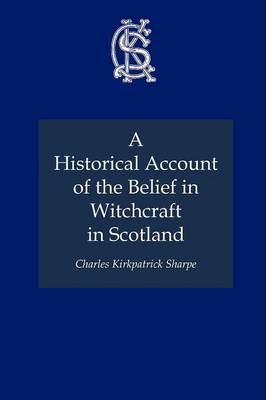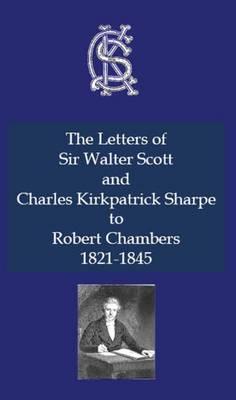Charles Kirkpatrick Sharpe Collection
5 total works
Letters From and To Charles Kirkpatrick Sharpe Esq.
by Charles Kirkpatrick Sharpe
Published 7 January 2011
This is Volume Two of two volumes of Letters from and to the Scottish antiquary Charles Kirkpatrick Sharpe (1781-1851), as first published in 1888. The material includes family letters, letters received by Sharpe from friends and society acquaintances, and his own correspondence as recorded in a note-book of 1810 to 1815. The editor, Allardyce, suggests that Sharpe's biography is written in his correspondence. Certainly the Letters both chronicle the development of his interests, particularly in Ballads, the Arts and Witchcraft, and furnish evidence of Sharpe's reputation for caricature and satire, a weakness for scandal, and an 'affection for archaism'. This second volume opens in Hoddam Castle, 1812, in the period preceding CKS's move to Edinburgh, where he was to devote himself to a life of literary, artistic and antiquarian pursuits. Correspondence continues with the Lord Gower (later the Duke of Sutherland), Lady Gwydr, Lady Charlotte Bury, Walter Scott, Robert Chambers and many others - painting a vivid picture of intellectual, political and society life throughout Europe, as viewed from Edinburgh.All peppered with frequent references to the difficulties of travel, illness and household trivia.
The volume closes in 1850, amid concerns for the great collection which CKS had by this time amassed. The illustrations include several reproductions of Sharpe's own drawings and etchings.
The volume closes in 1850, amid concerns for the great collection which CKS had by this time amassed. The illustrations include several reproductions of Sharpe's own drawings and etchings.
A Historical Account of the Belief in Witchcraft in Scotland
by Charles Kirkpatrick Sharpe
Published 31 December 2009
First published in this format in 1884, this early chronological account forms a complete overview of the history of witchcraft, "wizardry, and spectral appearances" in Scotland before 1724. An Editorial note introduces the author, Charles Kirkpatrick Sharpe (1781-1851), and explains how this present volume was originally written as an introductory chapter to Sharpe's 1819 edition of "Memorialls; or the Memorable Things that fell out within the Island of Brittain from 1638 to 1684 by the Rev. Mr. Robert Law." but came to be regarded as a work which was more important in its own right. A Biographical Sketch of the 'polished and aristocratic', 'capricious and eccentric' author follows, with a good description of the scope of Sharpe's correspondence, literary labours, etchings and collections. The historical account itself is presented in twelve chapters, with an Appendix, the editor's own compilation of a 'Short List of Books on Scottish Witchcraft and Superstition' and an Index.
The Letters of Sir Walter Scott and Charles Kirkpatrick Sharpe to Robert Chambers 1821-1845
by Sir Walter Scott and Charles Kirkpatrick Sharpe
Published 30 September 2010
The early life of Robert Chambers embracing the period of his connection with Sir Walter Scott has already been described by his brother William in the Memoir of himself. But while Dr William Chambers had acccss to many early papers now in my possession, he made little use of these, and printed no letters of this period. The letters of Sir Walter Scott printed in the Memoir of William and Robert Chambers (1872) were written at a later date, and have no reference to that subject which first awakened in the great man sympathy for a young and struggling literary aspirant. With the exception of the above-mentioned letters, any extracts now printed from Scott manuscripts belonging to me appear for the first time. One of these papers, recently discovered, is the first portion (incomplete) of a History of the Canongate, and may have formed part of that work on the antiquities of Edinburgh which Scott, in collaboration with Mr Skene of Rubislaw, had at one time intended to write.
After seeing the first two parts of Robert Chambers's Traditions of Edinburgh, Scott's original idea-as we are told by the author in his Preface to the last revised edition-was abandoned, and many of his notes handed on to his youthful protege and friend. The same Preface makes it no less clear that, besides Sir Walter Scott, Robert Chambers was equally indebted to Charles Kirkpatrick Sharpe for much valuable information. The series of letters from Mr Sharpe now printed, while slight and unimportant in themselves, are at the same time curious and original, besides being typical of the man himself, as described by contemporaries. Robert Chambers's account of Charles Kirkpatrick Sharpe is very striking, and gives a better idea of this eccentric genius than is to be found in any biography. It reads as follows: 'Looking back from the year 186S, I feel that C. K. S. has himself become, as it were, a tradition of Edinburgh. His thin, effeminate figure, his voice pitched in alt.-his attire, as he took his daily walks on Princes Street: a long blue frock-coat, black trousers (rather wide below, and sweeping over white stockings and neat shoes), something like a web of white cambric round his neck, and a brown wig coming down to his eyebrows-had long established him as what is called a character.
He had recently edited a book containing many stories of diablerie, and another in which the original narrative of ultra-presbyterian Church History had to bear a series of cavalier notes of the most mocking character. He had a quaint, biting wit, which people bore as they would a scratch from a provoked cat Essentially, he was good-natured and fond of merriment. He had considerable gifts of drawing, and one caricature portrait by him, of Queen Elizabeth dancing, " high and disposedly," before the Scotch ambassadors, is the delight of everybody who has seen it.
After seeing the first two parts of Robert Chambers's Traditions of Edinburgh, Scott's original idea-as we are told by the author in his Preface to the last revised edition-was abandoned, and many of his notes handed on to his youthful protege and friend. The same Preface makes it no less clear that, besides Sir Walter Scott, Robert Chambers was equally indebted to Charles Kirkpatrick Sharpe for much valuable information. The series of letters from Mr Sharpe now printed, while slight and unimportant in themselves, are at the same time curious and original, besides being typical of the man himself, as described by contemporaries. Robert Chambers's account of Charles Kirkpatrick Sharpe is very striking, and gives a better idea of this eccentric genius than is to be found in any biography. It reads as follows: 'Looking back from the year 186S, I feel that C. K. S. has himself become, as it were, a tradition of Edinburgh. His thin, effeminate figure, his voice pitched in alt.-his attire, as he took his daily walks on Princes Street: a long blue frock-coat, black trousers (rather wide below, and sweeping over white stockings and neat shoes), something like a web of white cambric round his neck, and a brown wig coming down to his eyebrows-had long established him as what is called a character.
He had recently edited a book containing many stories of diablerie, and another in which the original narrative of ultra-presbyterian Church History had to bear a series of cavalier notes of the most mocking character. He had a quaint, biting wit, which people bore as they would a scratch from a provoked cat Essentially, he was good-natured and fond of merriment. He had considerable gifts of drawing, and one caricature portrait by him, of Queen Elizabeth dancing, " high and disposedly," before the Scotch ambassadors, is the delight of everybody who has seen it.
This volume was first published in 1807, shortly after its author - the antiquarian Charles Kirkpatrick Sharpe (1781-1851) - graduated from Christ Church, Oxford. At this period his social and intellectual life combined Oxford, London and Hoddam Castle in Dumfriesshire, as he developed the interests and researches that were to occupy his life. There are nine works presented: The Fiend With Mantle Grey, The Lord Clifford's Song On Fair Julian; Sir Hugh; Stanzas Adapted To An Ancient Scottish Air; False Lord Carleil And The Fair Lady Alice; An Epistle From The Shade Of The Countess Of Roxburgh To The Honourable Miss Drummond Of Perth; Lines Suggested By A Passage In Osborne's Letters; Translation Of A French Poem, Composed On The Murder Of Henri, Duke Of Guise; Lorenzo And Isabella - From Boccaccio; The Murder Of Dumblane The original notes give historical and biographical context to the poems. The collection is dedicated to CKS's cousin, and regular correspondent, Miss Campbell of Monzie.
The antiquarian collector, Charles Kirkpatrick Sharpe (1781-1851), is remembered for his work and interest in literature, music and the fine arts. His studies - ranging from ballads and Scottish popular poetry to the origins and history of witchcraft in Scotland - remain key to understanding these subjects today. This volume - first published in Edinburgh in 1869, almost twenty years after Charles Kirkpatrick Sharpe's death - offers both an overview of his life and a more detailed introduction to the scope of two of his main areas of activity. The compilation begins with a Memoir, which uses extracts from CKS's notebooks and correspondence to present a character sketch of the man sometimes known as the 'Scottish Horace Walpole'. This is followed by a selection of Ballads and Other Poems, categorised as Romantic and Sentimental, Comic and Satirical, and of Prose Fragments. CKS's particular skill as an artist and humorist was noted by Sir Walter Scott, in his diary of 1825, where he declared his friend's drawings as "the most fanciful and droll imaginable - a mixture between Hogarth and some of those foreign masters who painted temptations of St.Anthony, and such grotesque subjects".
The final section of this volume contains a catalogued selection of twenty-seven Etchings and nine Drawings.
The final section of this volume contains a catalogued selection of twenty-seven Etchings and nine Drawings.




